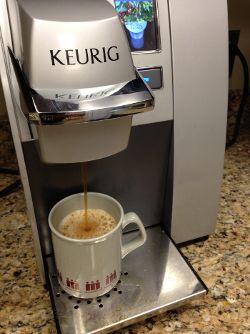Who would’ve thought it possible that digital rights management (DRM) would come to the coffee business? Well, it has. Believe it or not, Keurig now includes DRM on their coffee makers. Why? To keep users from using anything but Keurig coffee pods on their machines, of course. You know, just like the DRM used by some printer manufacturers to keep you coming back (and coming back) for their branded replacement ink cartridges instead of opting for the much cheaper store brand.

What’s worse, even some Kerug branded pods are not DRM ready, and good luck getting a refund if that turns out to be the case.
I learned about Keurig’s DRM use last week on The Verge.
“Late last year, Keurig announced a new machine, the 2.0, calling it the ‘future of brewing’ and touting its ability to make both small cups and large carafes. But another, less-publicized feature has been getting most of the attention: the brewer’s advanced scanning system that locks out any coffee pods not bearing a special mark. It’s essentially a digital rights management system, but for coffee, and it’s proving to be the brewer’s downfall.”
It’s turning into a “downfall” partly because of those already mentioned not-DRM-ready pods. Evidently, somebody with Keurig thought it wasn’t important to remove all of the company’s old pods from store shelves with the release of the new machine — meaning many just purchased pods might not contain the all important special mark and won’t work on new machines. Oops! It also turns out that consumers aren’t any happier about DRM “protected” coffee makers than they are about “copy protected” movies or software “activation” schemes. Need proof? Last quarter, the first full quarter that the 2.0 model was available, Keurig’s sales fell 12 percent.
You might be excused for thinking this is a patent issue — that this is merely a way for Keurig to make sure no competitor infringes on its patents. Even if we excused you for thinking that, you’d still be wrong, as Keurig has made this a copyright issue.
Back in 2012, Keurig’s patents on its pods expired, opening the door for competitors to legally market cheaper pods, which ended the company’s huge share of the pod market pie. Remember, just as inkjet printer companies make the lion’s share of their money selling replacement ink cartridges, Keurig makes most of its money selling incredibly expensive coffee pods. So, with no patents to protect them, Keurig turned to copyright law, as SecurityCurrent explained last March when the DRM plan was first announced.
“So when you buy a coffee maker, you will not only purchase an expensive piece of hardware…but you will also enter into a software license agreement with Keurig. You will license the software in the K-cup…subject to whatever terms and conditions Keurig wants….”
And anyone who doesn’t abide by these terms could be sued for copyright infringement.
“While the company may have zero leg to stand on for breach of contract (in state court) or defamation (also in state court), the terms of the software license agreement on the cup of coffee gives them the right to haul you into Federal Court wherever it is convenient to them. It also provides for statutory copyright damages — $150,000 per infringement. Oh, and each pod use is a separate infringement. Four cups of Joe – a cool 600K!”
Oh, and by circumventing the machine’s built-in DRM, you might find yourself open to federal criminal charges under the Digital Millennium Copyright Act (DMCA).
“…the DMCA includes not only civil damages, but also criminal enforcement. So if you knowingly use the ‘infringing’ pod, you are circumventing a technological protection designed to protect a copyrighted work. And you thought you were just brewing a cup of Sumatra!”
However, there is some good news.
Back in the first decade of the 21st century, Lexmark tried the same thing by adding DRM to its incredibly expensive ink cartridges to keep owners of Lexmark printers from being able to use cheaper third party replacement cartridges. When one company, Static Control Components (SCC), reverse engineered around the DRM, Lexmark sued, citing the DMCA. They lost.
I imagine the same thing would happen if Keurig would be foolish enough to take the proud owner of one of their machines to court.
Christine Hall has been a journalist since 1971. In 2001, she began writing a weekly consumer computer column and started covering Linux and FOSS in 2002 after making the switch to GNU/Linux. Follow her on Twitter: @BrideOfLinux









One of many videos, to “at your own risk”, solve this problem:
https://www.youtube.com/watch?v=68DtMuorDMk
This DRM thing is becoming a little bit too ridiculous really.
Stop buying crap! If they are advertizing something
it is not to help YOU it is to make THEM richer.
Open Source? Great idea but it is not catching on, eh?
Everyone should boycott these anyway, they are an environmental disaster.
Not to mention a VERY expensive single cup.
This article slowly came back to me while I was getting my coffee this morning. Through non-focusing eyes, I saw the name on the machine and read, “Krueger,” as in Freddy Krueger. Didn’t wake me up, but forced me to try to think with my non-focusing brain.
@drgb I agree with all you said. However, I’d bet that some incredible percentage of these were purchased as gifts and not by the person who would be stuck with using it and paying for the coffee. Ours was a gift,of course. We received it a few years ago and it doesn’t have the DRM feature. I have a friend who makes it a point to restate her opposition to receiving one at every holiday.
When we first received it, I let my wife use it with the expensive coffee, as a protest or something. I used our old coffee maker, a cheapie from the company that started all the drip coffee maker with carafe business. I figured my partial pot cost less than her single cup.
And then somebody told my wife about the plastic fake cups. They’ve been at the store where some things cost around a dollar, generally. They’re in a pack of four for about ten bucks and look flimsy, so I bought another set. All eight of them are still in great shape and we use about three of them every day. They’re a lot easier to clean than the single cup gadget from Keurig, BTW.
I felt more guilt about retiring the old faithful coffee maker than about ripping off Keurig by using the little cup things. The old coffee maker is still on a shelf–in reserve, as it were.
It’s a bit nuts that we have to hack a coffee pot. Nice to see that DRM is so flipping easily foiled by tape. 🙂